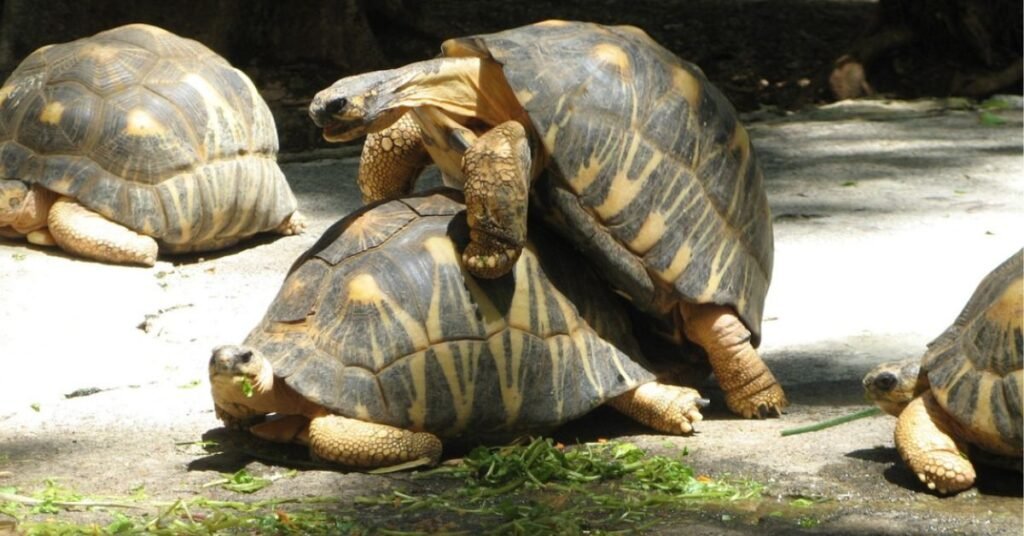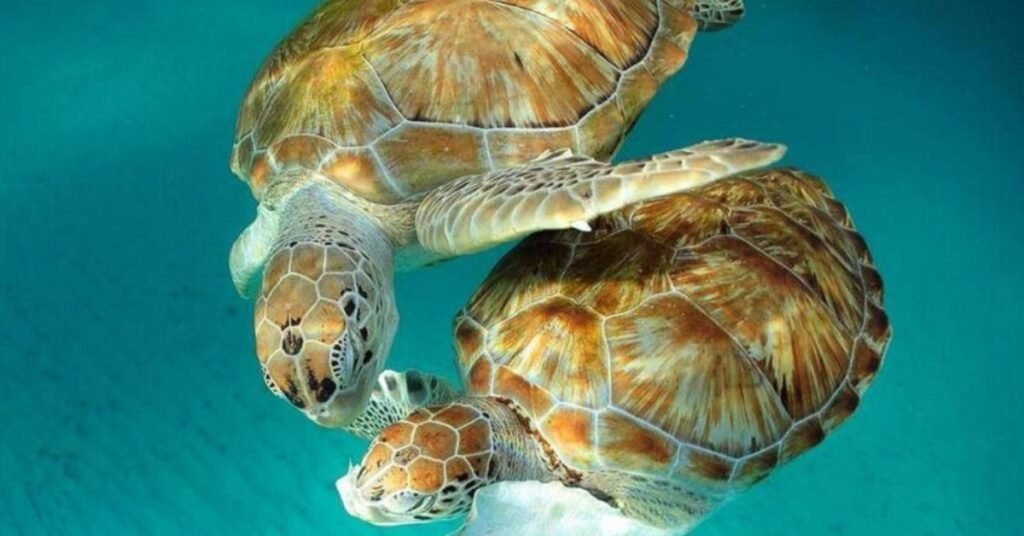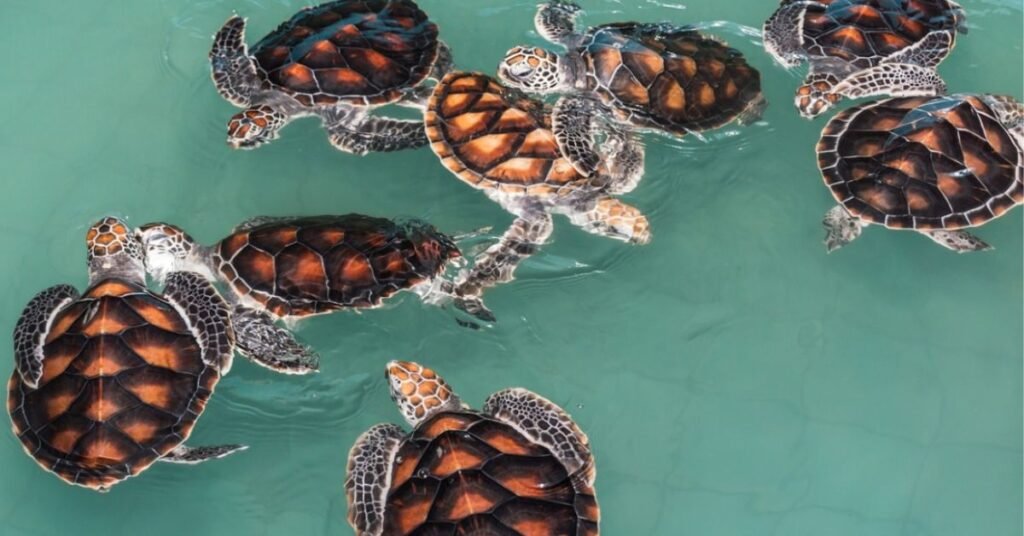Turtles have lived around 230 million years, and this time is more than human existence on Earth. As they were going through the reproduction process, this is the only reason they are still existing. But still, do you have this question in mind: “Do Turtles Have Intercourse”?
Without going through the mating or intercourse process, how would they continue their reproduction? The answer is quite obvious: via mating or intercourse, they continue their generation.
The truth is that studying turtles’ mating process is fascinating. Turtle mating involves complex rituals and behaviors, which vary between species. For aquatic turtles, this process takes place in water, and for land dwellers, it takes place where they live. In this post, let’s dig into the question: Do Turtles Have Intercourse, and how do they do it?
Table of Contents
Do Turtles Have Intercourse?

Yes, they do, and it’s a fascinating process. Male turtles often engage in courtship displays to attract females, such as head bobbing and gentle nuzzling. This intricate dance can last from a few minutes to several hours, a maximum of 8 hours for sea turtles.
After successful mating, female turtles come ashore to lay their eggs in carefully dug nests. For aquatic turtles, the actual mating takes place in water, where the male securely grasps the female’s shell with his claws. Tortoises or land-living terrapins find safe places on land, on rock surfaces, or any muddy surface.
How Do Turtles Have Intercourse (Mating Process)?

Turtles mating process is fascinating. Let’s see what is their process:
Courtship Rituals
Initiation: Male turtles start the courtship by gently biting the female’s neck or flippers. This action signals that the male is interested in mating. If the female does not try to escape, it shows she is receptive to the male’s advances.
Approach and Signals: Males use visual and tactile signals to approach females and check their willingness to mate. If the female is willing, she stays still, allowing the male to continue with the mating process.
Mating Procedure
Climbing and Positioning: The male climbs onto the female’s back and uses his sharp claws to grip her shell securely. This positioning ensures that he can hold on during the mating process. Unfortunately, this can cause scratches and minor wounds on the female’s shell and soft body parts.
Mounting and Copulation: The male extends his tail beneath the female’s shell to inseminate her cloaca, where the reproductive organs are located. This process can happen either on the water’s surface or underwater. Both male and female reproductive organs are located at the base of their tails in their cloacas.
Duration: The mating process can last for several hours. During this time, the female must support both her weight and the male’s. She also needs to swim to the surface regularly for air, making the process quite strenuous.
Competition and Multiple Mates
Male Competition: Multiple males often compete for a single female. This competition can be aggressive, with males biting and scratching each other to gain access to the female. The male holding onto the female tries to keep other males from dislodging him.
For example, Sea turtles migrate epic distances to reach their nesting grounds and engage female sea turtles. With their flippers and shells, they try to attract female turtles with a captivating ballet.
Land turtles like Box turtles, for instance, have their unique way of charming a mate. The male circles the female in slow motion, displaying his vibrant shell and surprising agility. It’s a courtship dance, witness to the fascinating diversity of the turtle world.
Female Strategy: Females often mate with multiple males and store sperm from different partners. This strategy ensures that all her eggs are fertilized, which helps the genetic diversity of the offspring. A female can lay several clutches of eggs in one season, each fertilized by sperm from different males.
What Is The Age of Sexual Maturity of Turtles?
What is the right age for the turtle to go through mating? Let’s see –
Age of Maturity
Turtles reach sexual maturity at different ages, and it varies among species. For example, leatherback turtles typically mature between 7 to 13 years. In contrast, green sea turtles can take significantly longer, and they reach maturity between 26 to 40 years.
There are a variety of factors that influence these differences, such as diet and the environment. Green sea turtles feed primarily on sea grasses and algae, while leatherbacks consume jellyfish and soft-bodied animals. So, leatherbacks mature more quickly than green sea turtles.
Size at Maturity
Turtles have different sexual maturity levels and physical size based on species. For example, Hawksbill turtles reach maturity when their carapace measures 69 to 78 centimeters (27 to 31 inches). Loggerhead turtles mature at a carapace size of about 50 to 87 cm (20 to 34 inches).
Leatherback turtles, among the giant sea turtles, reach maturity at a carapace size of 145 to 160 cm (57 to 63 inches). Interestingly, some turtle species continue to grow even after sexual maturity, while others stop growing once they mature.
When Is Turtles Mating Season and Frequency?

For mating, turtles follow a certain season. However, it varies depending on species –
Seasonal Timing
Turtles typically mate during specific seasons, which are often related to environmental conditions. For most species, courtship activities begin several weeks before the nesting season. This timing ensures that the eggs are laid during the optimal conditions for their survival.
For example, female sea turtles usually nest during the warmest months of the year, although leatherback turtles are an exception, nesting in fall and winter.
Frequency
The frequency of mating varies among turtle species. Some turtles mate annually, while others may mate multiple times a year or follow a biennial pattern. For instance, sea turtles do not nest every year but rather every second or third year.
During a nesting season, females may lay between 1 and 9 clutches of eggs. Green sea turtles, for example, can lay between 1,900 to 2,300 eggs over their lifetime.
Nesting and Egg-Laying in Turtles
After successful mating, it’s time to nest. Here are the following nesting process of most turtle species:
Nesting Sites
In most cases, female turtles come ashore to lay their eggs on sandy beaches. Semi-aquatic and terrapin turtles, such as the northern diamondback terrapin, also choose sandy soils above the high tide line for nesting.
The nesting season usually occurs from May to September, during the warmer months. Most species prefer to nest at night. However, some species, like the Kemp’s ridley turtle, may nest during the day in a mass event known as an arribada (a Spanish word).
Nesting season for terrapin turtles is usually May to July. Terrapins often nest in areas close to their aquatic habitats, which include brackish waters—a mix of salt and fresh water found in coastal marshes and estuaries.
Nesting Process
During nesting, the female turtle picks a spot above the high tide line. The nesting process is similar to that of most turtle species. Using her hind flippers, she digs a body pit and shapes it into a vase-like egg cavity about two feet deep. In this way, the eggs are buried safely and protected from predators.
Once the egg cavity is ready, the female lays her eggs in clutches. The number of eggs per clutch varies by species. For example, green sea turtles typically lay about 110 eggs per clutch, while other species may have different clutch sizes.
After laying the eggs, the female covers the nest with sand using her hind flippers. This safety process protects eggs and maintains temperature and moisture levels.
Egg Characteristics
Turtle eggs are soft-shelled and leathery rather than complex like bird eggs. They are surrounded by thick, clear mucus, which provides additional protection and prevents them from drying out. This unique texture helps the eggs remain intact and moist even when buried in the sand.
The temperature of the sand where the eggs are incubated plays a crucial role in determining the sex of the hatchlings. Cooler temperatures tend to produce male hatchlings, while warmer temperatures result in females.
Incubation and Hatchling Emergence in Turtles
Turtle eggs generally incubate between 45 and 90 days, depending on species and environmental conditions. As we already mentioned, temperature plays a crucial role in determining the sex of the hatchlings.
Lower temperatures produce more males, while higher temperatures produce more females. For example, green sea turtle nests at 28°C (82°F) or below mostly breed males, and nests at 31°C (88°F) or above mainly produce females.
Hatchlings use temporary egg teeth to break out of their shells. It can take 3 to 7 days for them to dig their way to the surface. They typically emerge at night to avoid predators. After reaching the surf, they swim quickly for about 24 to 48 hours to reach deeper waters (sea turtles), where they are safer from predators.
Threats to Turtle Reproduction
Human Activities
Coastal Development: Coastal development disrupts nesting sites, forcing turtles to find less optimal locations. About 40% of Florida’s beaches, crucial for sea turtle nesting, are critically damaged.
Pollution: Over 1 million marine animals, including turtles, die annually from plastic debris. Turtles often mistake plastic for food, leading to illness or death. Chemical pollutants and oil spills also contaminate their habitats.
Hunting and Egg Collection: In many areas, turtles are hunted for their meat, eggs, and shells despite legal protections. Hawksbill sea turtle populations have declined by 90% over the past 100 years due to illegal trade.
Natural Predators
Eggs and hatchlings are vulnerable to predators like raccoons, crabs, and birds. Only about 1 in 1,000 to 10,000 hatchlings survive to adulthood1.
Climate Change
Temperature Changes: Higher temperatures produce more female hatchlings, while lower temperatures produce more males, affecting sex ratios and genetic diversity.
Rising Sea Levels: Sea level rise and stronger storms reduce nesting beach sizes and contribute to coastal erosion.
Read More: Can Turtles Live With Fish?
Summary
Intercourse or mating is essential for turtles’ reproduction. Male turtles often compete to win over a female, and once they succeed, mating happens. Despite numerous threats like coastal development and climate change, turtles continue their ancient mating rituals.
So, next time someone asks, “Do turtles have intercourse?” you can confidently say yes, and it’s a fascinating event to witness.
